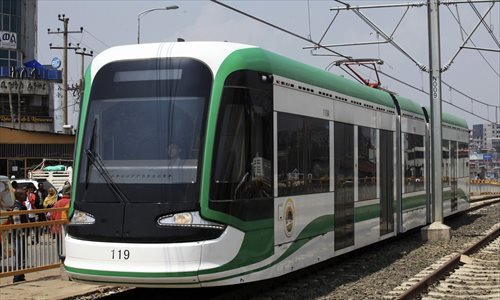The gravy train
China's high-speed rail goes global, benefits world

A train runs through Addis Ababa, Ethiopia on sub-Saharan Africa’s first light rail system in September, which was built by the China Railway Group. Photo: IC
One day before President Xi Jinping started a four-day state visit to the US, it was confirmed that the first US high-speed railway funded with Chinese investment will start construction in September 2016.
The 370-kilometer China-US partnership project, known as the Xpress West high-speed railway or the Southwest Rail Network, will connect Las Vegas, Nevada and Los Angeles, California.
After technological upgrades and innovations, Chinese high-speed railway technologies are now some of the most advanced in the world.
Of the over 110,000 kilometers of railways that Chinese companies have built, the 16,000-kilometers that are high-speed lines account for more than half of the world's high-speed lines.
Railways built with Chinese investment have benefited many countries and regions economically and socially by creating jobs and facilitating transportation, among other interests.
Before Xi started his first state visit to the US since taking office in 2013, the XpressWest company agreed earlier this month to form a joint venture with China Railway International USA to build and operate the line, said Shu Guozeng, deputy head of the Office of the Central Leading Group for Financial and Economic Affairs of China.
It has been agreed that implementation of necessary regulatory and commercial activities will begin within the next 100 days. With $100 million in initial capital, the new high-speed rail line is expected to create jobs throughout the interstate corridor.
"The project will be a landmark in overseas investment for the Chinese railway sector and serve as a model of international cooperation," said Yang Zhongmin, chairman of China Railway International.
With the US project, Chinese railway projects will cover nearly all inhabited continents, as China's railway equipment manufacturers have sped up efforts to "go overseas."
In 2014, China's first overseas high-speed railway project was completed in Turkey, where a 533-kilometer railway links capital Ankara with Istanbul.
In Africa, Chinese-built railways have been or will be the backbone of local public transport systems and a key component of growth in a number of countries, including Nigeria and Ethiopia.
After a 1,344-kilometer railroad project in Angola was put into operation in 2014, China signed a deal last May to build a rail link worth $3.8 billion between the two Kenyan cities of Mombasa and Nairobi, the first phase of a line that will eventually connect countries including Uganda, Rwanda, Burundi and South Sudan.
In the Asia and Pacific region, the fastest meter-gauge multiple unit trains made by a Chinese company were put into operation in Malaysia earlier this month. Laos, Thailand and Russia are also planning to build railway lines with Chinese investment.
In South America, trains made by China began running on the Mitre commuter route in the Argentine capital of Buenos Aires last November. In Macedonia, Chinese trains will be running soon as the country inked a deal with China in June to purchase six fleets of high-speed trains.
Building relationships
The Chinese railway industry has become a means of diplomacy as China's bullet trains and high-speed rail have become buzzwords in news coverage of meetings between Chinese leaders and their overseas counterparts.
Zhang Yiwu, a professor at Peking University, lauded the Chinese railway sector, saying "high-speed trains mark China's rising power and influence globally."
As an advocate of Chinese high-speed rail, Premier Li Keqiang has made all-out efforts during many trips abroad to highlight the country's high-speed rail technology, saying it ensures cost-effective projects without sacrificing quality.
In October 2013, Li's speech at the Thai parliament was widely reported by global media outlets, with many focusing on his "sales pitch" on behalf of China's railway industry.
One month later, he stressed the advantage of Chinese railway equipment and technologies in addressing a trade forum between China and Central and Eastern European countries in Bucharest, Romania.
In May 2014, Li said at the headquarters of the African Union in Ethiopia that China would actively participate in infrastructure projects in Africa and build a high-speed rail research center on the continent.
Inclusive economy
The purpose of Chinese leaders' promotion of China's railway projects abroad is to boost cooperation, and achieve common development and prosperity.
With Chinese high-speed railways and standards globally recognized, related projects have become a highlight in production capacity cooperation between China and other countries, according to experts.
Building railways abroad and exporting related equipment and technologies lead to all-win situations for both China and its foreign partners, as such cooperation will facilitate China's endeavor to upgrade its national economy and allow partner countries to enjoy all the benefits of these projects at lower costs.
Chinese companies and those in developed nations may work together to produce high-quality, inexpensive equipment and develop huge markets in third-party countries, Li recently told the annual meeting of the Summer Davos Forum in Dalian.
China is ready to buy technology and equipment from developed countries and combine them with its mid-range equipment to satisfy the needs of developing nations, serving as a bridge for international cooperation in production capacity, he said.
China's proposal of building the "Belt and Road" and expanding international cooperation in production capacity, said Li, would further open up China's economy, allow each country to display its comparative strengths and help forge a more balanced and inclusive global industrial chain.
Huang Bin, a China expert with the Thai think tank Kasikorn Research Center, noted that the railway project between Thailand and China, once completed, could serve as a model for China's "Belt and Road" initiative and demonstrate to the world how projects of this kind can promote development.
Xinhua